The Happiness Score™ report provides insights on the state of Enterprise IT Experiences across all IT touchpoints, based on almost 1.151.269 responses between 1. July 2021 and 31. Dec 2021.
Download as PDF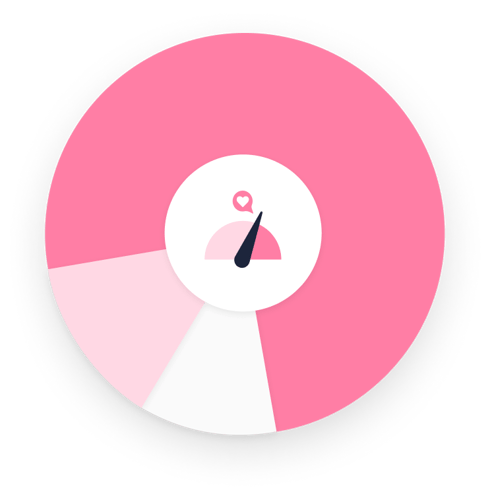
Introducing the Global IT Experience Benchmark.
The H2/2021 report now includes data and insights across all touchpoints with IT.
The report is based on continuous data collection through the HappySignals Experience Management Platform for IT.
In total, there were 1,151,269 end-user responses from our Enterprise customers between July 2020 to Dec 2021.
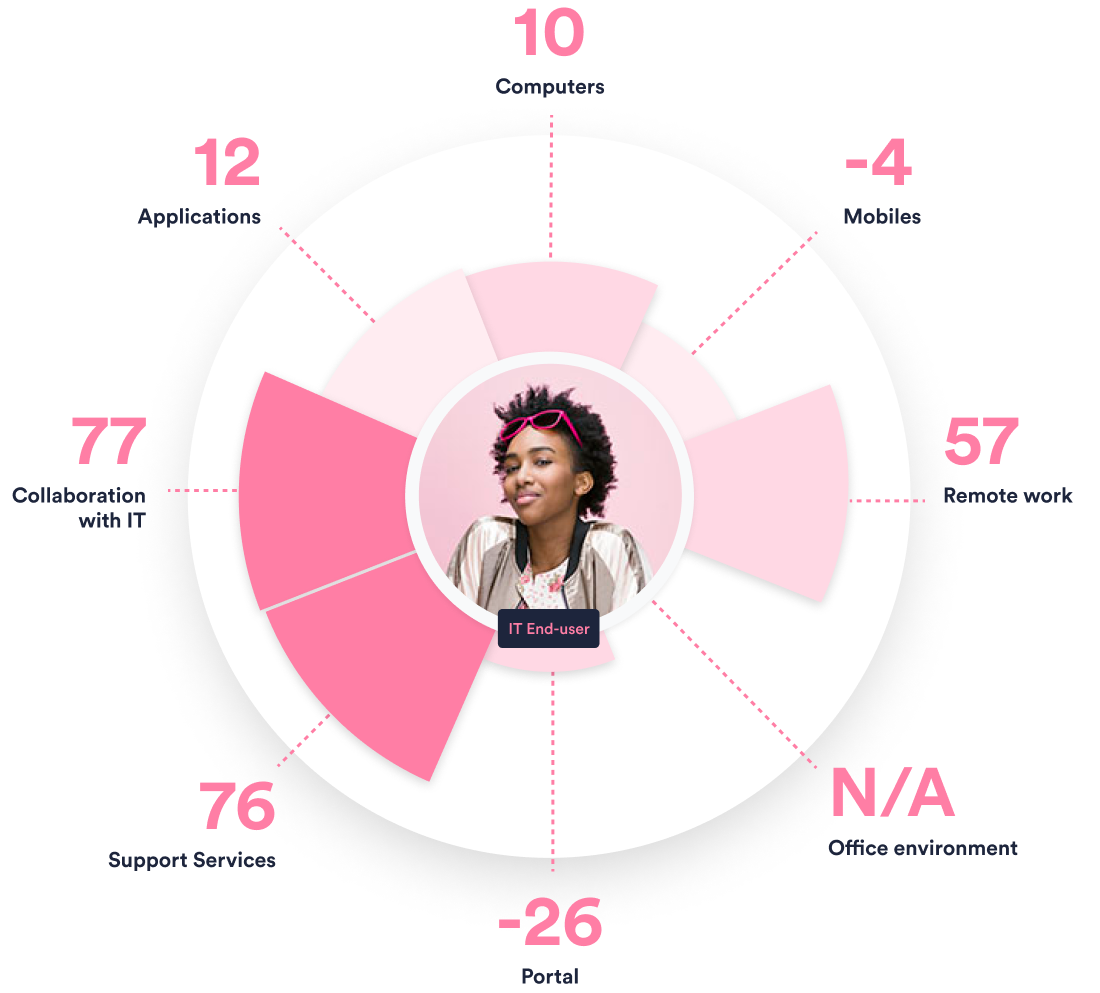
When reading the report, keep in mind that the results reflect the success of IT teams that have chosen to focus on people first.
Our customers have aligned with business stakeholders to put end-user happiness as the primary indicator of success in service delivery.

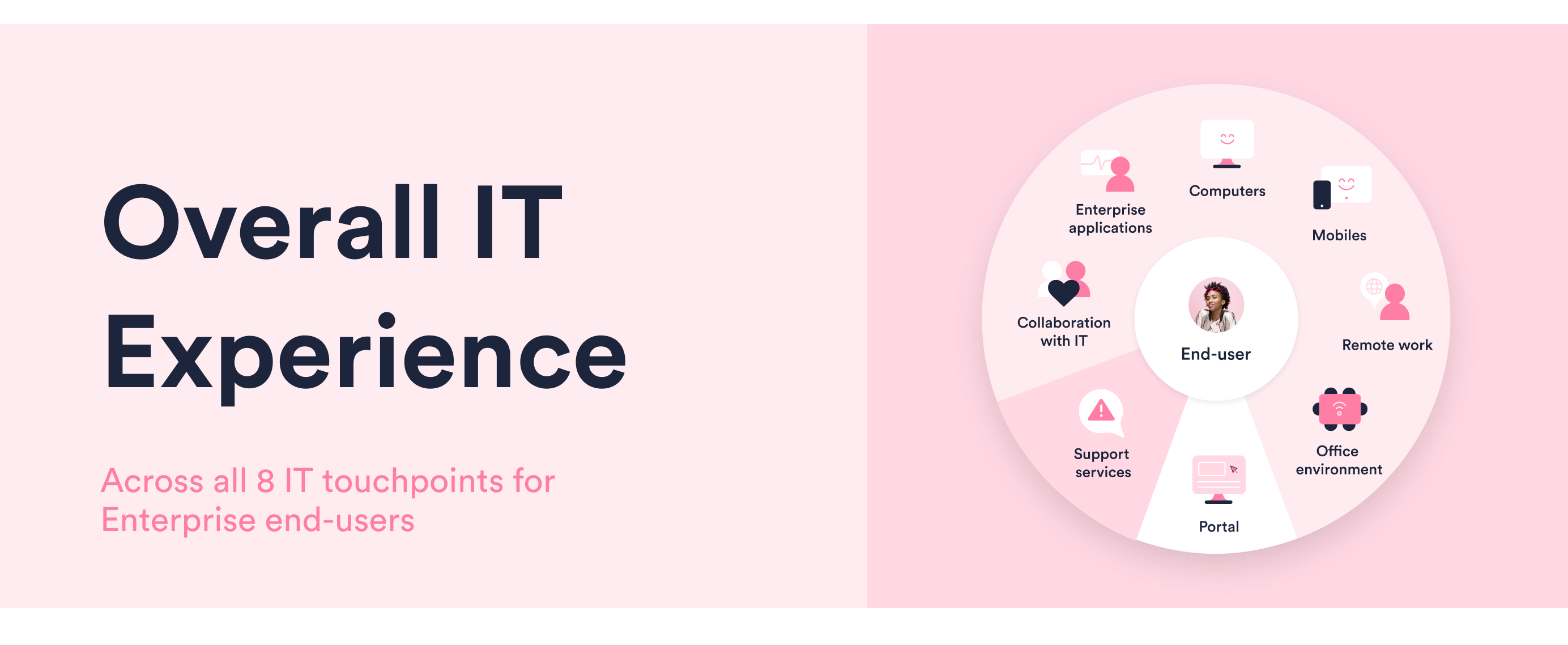

Collaboration with IT
In the collaboration with IT the most important factor seems to be whether end-users are clear about who to contact for IT-related issues. That is the second most important factor for end-user happiness and the biggest reason for dissatisfaction.
Most people (58%) feel it is nice to work with IT. On the other hand, 24% have encountered attitude problems during collaboration with IT.
Service Portals
Service portals are being used more and more. When looking at experience scores around portals, it is important to understand how end-users rate portal as a tool vs rate the service experience that started in a portal.
Portal as a tool gets the lowest score of all IT touchpoints -26 points.
When a ticket-based interaction starts in portal, the scores are not very different from other channels: 76 for incidents and 79 for requests. However, those scores reflect the service experience that IT provides and are not representative of the score end-users would give the portal from a user experience point of view.
Enterprise applications
With applications the range of scores between different types of applications and across different customers is quite large. It is not uncommon to have applications that receive a negative score (the score becomes negative if there are more people rating their experience with 0-6 than those rating it 9-10). Further, even the highest scores for applications are not even close to the average of the scores for support services.
The complaints about applications are more often about the speed of the application or the speed of application-related development. Many also feel that applications are not helping them enough to be efficient.
Some positive feedback about applications are that they are modern and easy to use, the content is up to date, and people are happy with the support they receive from that application.
Laptops and/or computers
For laptops and/or computers, the main negative feedback is related to speed of the device. The second biggest reason for dissatisfaction is short battery life, followed by malfunctioning device. The fourth biggest pain point is the mandatory settings and software that decreases device efficiency.
From those people who rated their device with 9s or 10s,
- 70% said their device is fast enough
- 66% said their device is always reliable
- 55% that the software is up to date
Mobile devices
Unsurprisingly, with Mobile devices the battery life is the most annoying thing for end-users. This is followed by limitations caused by the device model, functionality of the device or subscription.
On the positive side, employees appreciate the efficiency boost they get from their phone. Other aspects like roaming, speed of the subscription, or getting the model that an employee wants all influence satisfaction to similar degrees.
Office Environment
Due to the present Covid situation, we don’t have enough data to reveal the score for this area yet. But if you want to understand if the office environment needs of end-users in your organisation have changed, don’t hesitate to contact us and start to measure this area as well with HappySignals.
If a company has less than 5000 employees, their happiness is on average about 12 points higher than companies with more than 20,000 employees.
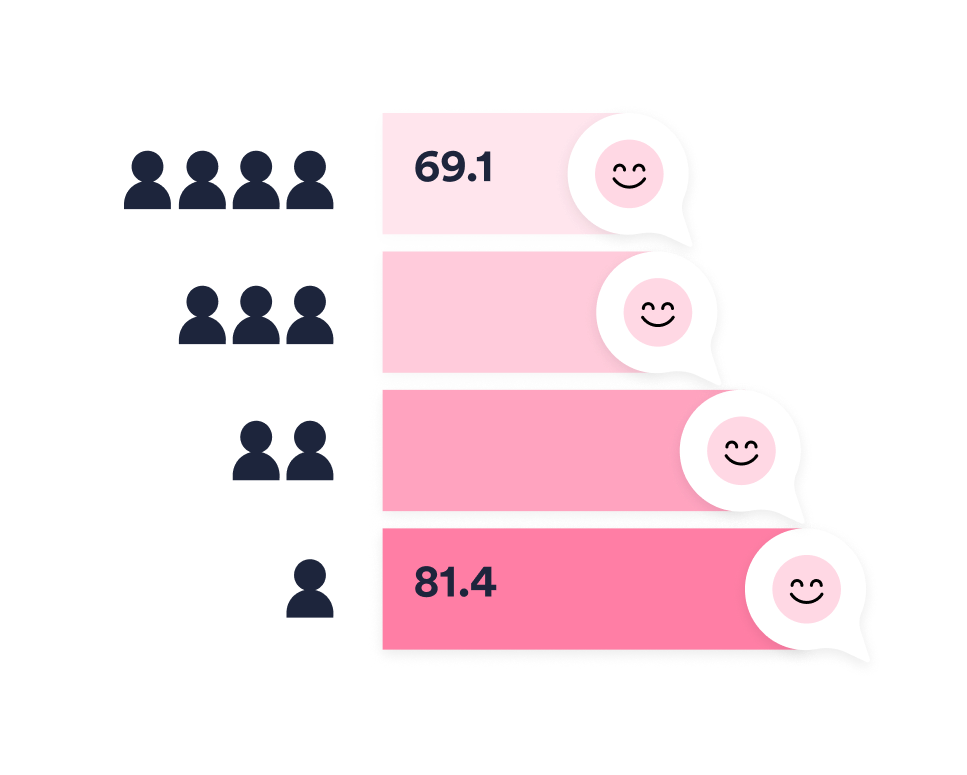
Based on 423,510 responses for IT incidents
* The average 4% budget is defined as including the dedicated personnel for IT Service and Support
| Included | Not included |
| Level 1 Service Desk | Vendor Support |
| Self help, self service portal | Level 3 IT Support |
| Field services | |
| Desktop support |
The difference in IT end-user happiness between the happiest and unhappiest industries is marginal – only 12%.
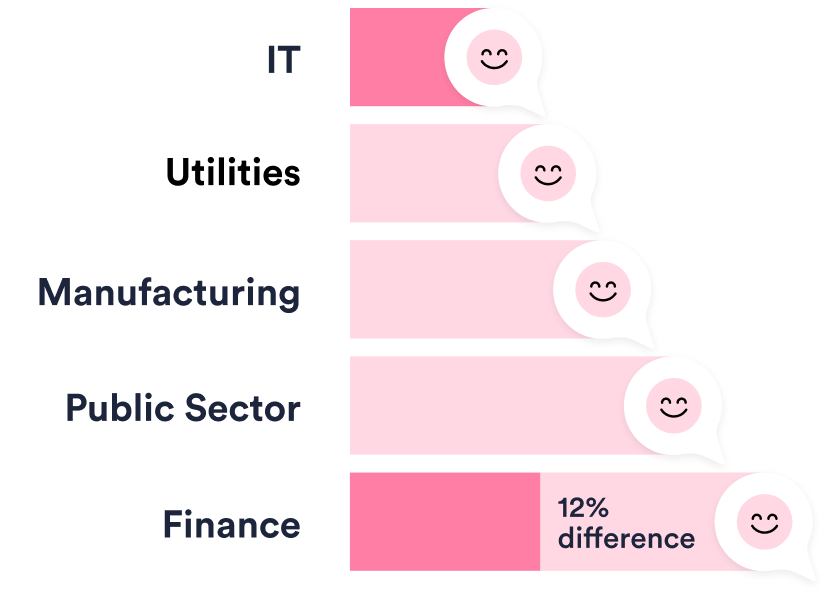
Based on 423,510 responses for IT incidents
This is the first report in which we are releasing any information about the differences between industries. We still do this with caution because we have learned that there are so many other factors apart from industry that can influence happiness.
The scores are established by creating a weighted average that eliminates variations due to country specific differences in rating happiness.
Before we can release comparisons across more industries and more exact scores for different industries, we have to account for the impact of company size and whether the service desk is internal or outsourced.
It appears that in Finance and the Public Sector, it is slightly easier to make end-users happy. These industries have stricter regulations, making them more stable in their ways of working. That could be a factor that impacts how IT can match end-user expectations in their interactions.
The fact that end-users in IT companies are the most demanding is not a huge surprise.
Employees in IT companies are likely to be more technically-skilled Doers who already solve the simpler IT issues by themselves.
IT support is likely to see less of easy "know-how incidents" and receive more complex problems that IT company employees were not able to solve by themselves.
The perception of lost time increases by roughly +1.5h every time a ticket is reassigned
The faster you can get the ticket to a team or individual that can solve the ticket, the better is the end-user experience.
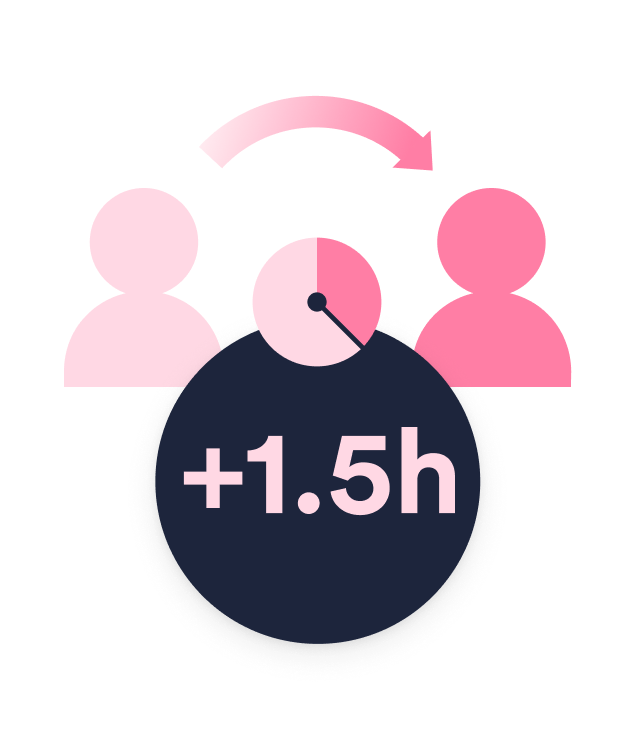
Based on 423,510 responses for IT incidents
One reason is that External IT providers often have better processes for using experience data in their daily work.
As a result, external IT Service Desks have almost caught up with internal ones in overall happiness.
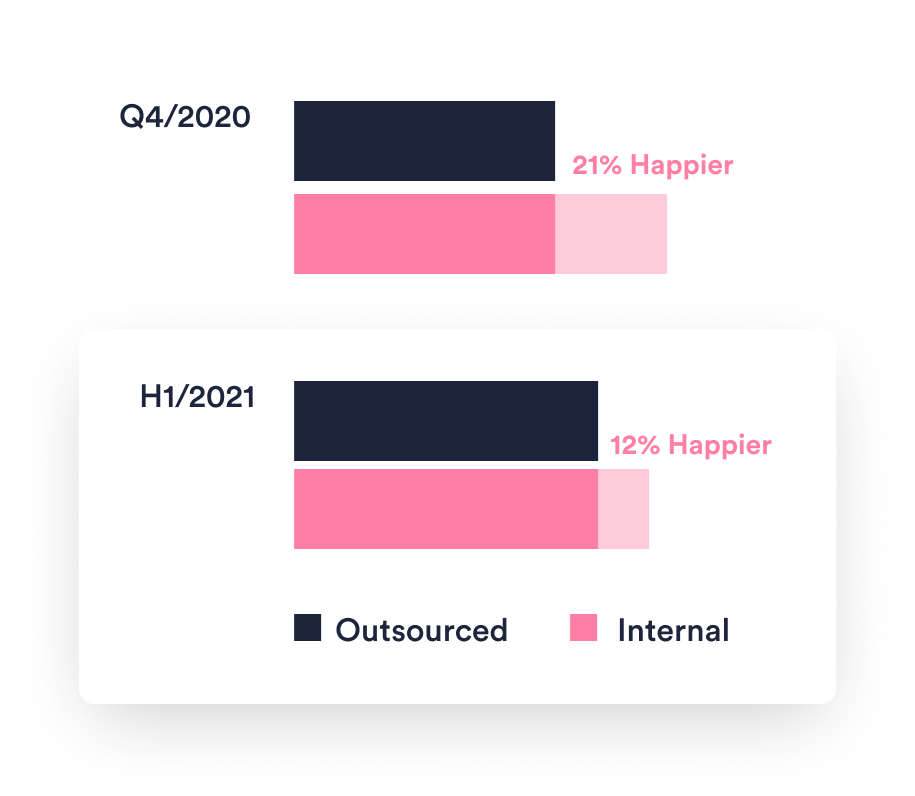
Based on 423,510 responses for IT incidents
Also the fact is that at least in our customer base the bigger the organisation it is more likely that the organisation has outsourced their service desk. In this report we are always analysing results based on all our customers. In that group if company has less than 5000 employees only 33% have outsourced their service desk, but if the company has more than 5000 employees, as many as 73% have outsourced their service desk.
In bigger companies with more than 5000 employees, the outsourced IT Service desk is just as good or better than an internal service desk.
Read more about internal vs outsourced ITBased on 395,500 responses for IT incidents
When companies have more than 5000 employees, outsourced service desks are preforming better than internal one.
We believe that makes lot of sense because the outsourced Service Desk is better suited to provide services globally without limitations due to time zones among other strengths in service delivery - being solely focused on a specific aspect of IT.
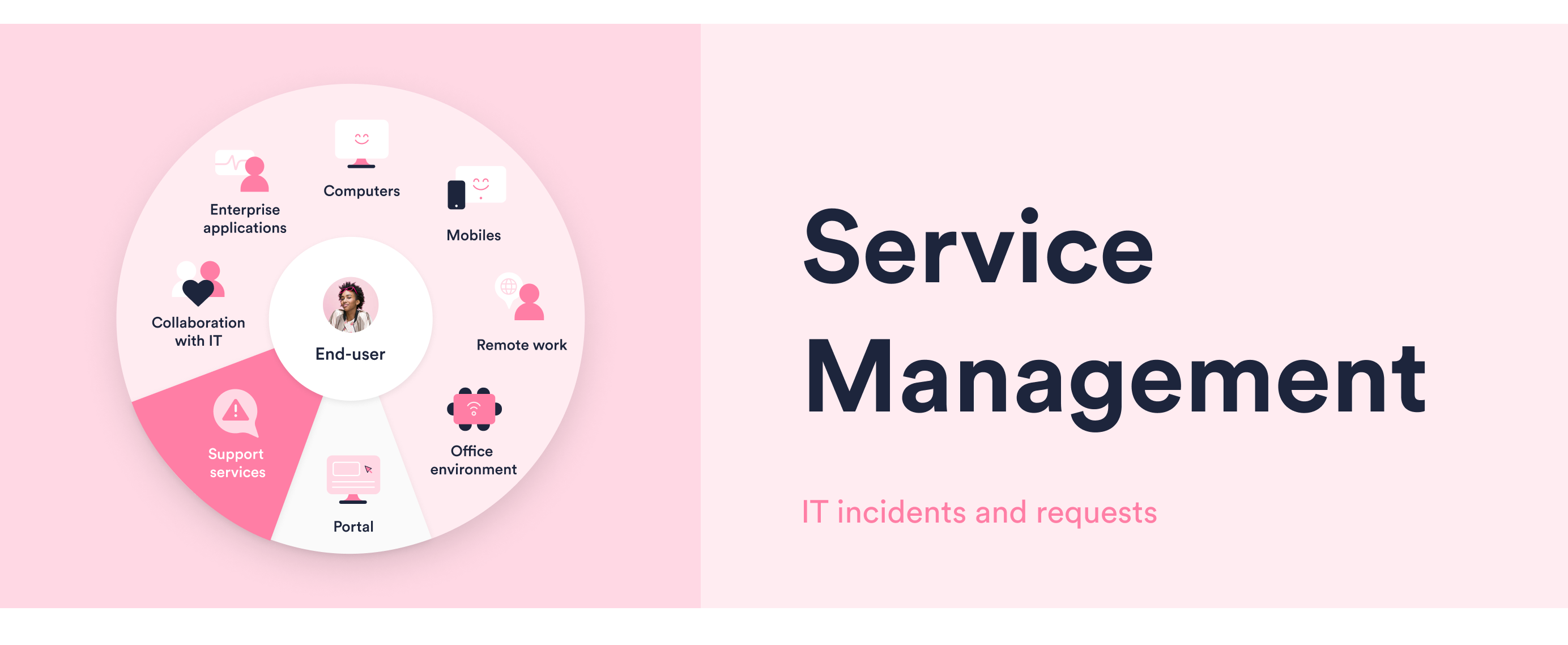
During the Covid-19 year, the happiness of end-users with IT Support Services has continued to increase.
The average end-user happiness among HappySignals customers in May 2021 is at a record high of +75, a 13% increase from Q4/2020.
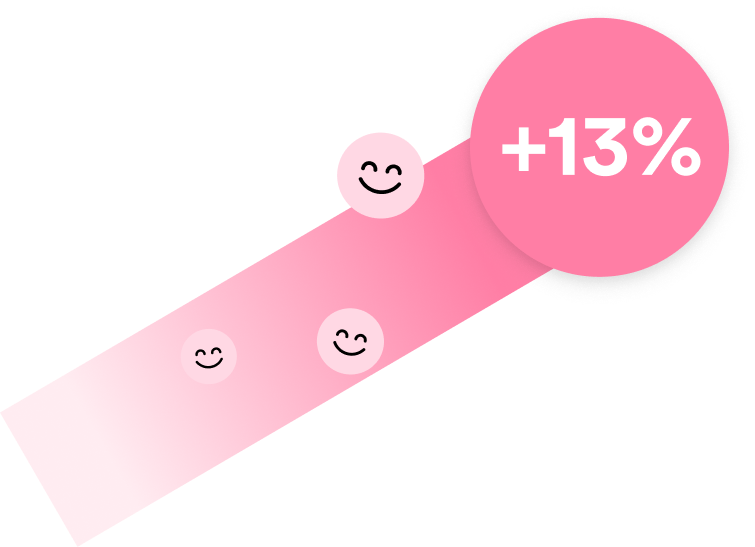
Based on 423,510 responses for IT incidents
One of the most valuable aspects of the HappySignals IT Experience Management platform is its ability to draw links from Happiness and Productivity to different reasons causing end-users' happiness or dissatisfaction. We call these reasons factors of happiness.
End-users' assessment of these factors are surveyed when they receive the resolution email. This makes the information about different factors very pertinent, as it is assessed at the moment of the closing of an incident or request ticket.
Different factors are presented to end-users to choose from, depending on the overall happiness rating they give (out of 10). For example, scores from 0-6 are classified as a negative experience, so end-users are asked to select from a list of factors tailored for negative experiences. The same goes for scores from 7-8 (neutral experience), and 9-10 (positive experience). Certain personnel-related factors are included in all three scenarios.
End-users can select as many factors as they wish from the options available.
End-users rate services in ways that reflect their cultural context. Having benchmark data can help us understand what the real IT performance level is in a country-specific context. That can help with resource allocation and prevent a few gray hairs.

+56 Germany (+2)
+56 Belgium (+2)
+57 Netherlands (+5)
+62 Switzerland (+3)
+63 Italy (+5)
We have learned that globally, factors are extremely stable! And they should be, because they reflect the real reasons why people are liking or hating the service they get.
But for our customers, the important actionable insight is that if their score deviates from the global benchmark by more than 5%, they are either doing something extremely well or have areas for improvement.
Speed of Service
We have been investigating the correlation between end-users' perceived experience and traditional SLA’s.
Some SLA's measure time to resolution by pausing the clock outside of business hours, or while the ticket is in another way in a transition state.
From our comparison between happiness and speed of service, the only time that really matters to end-users is the time from the moment they submitted a ticket, to the moment the ticket is solved.
This is often referred to in the SLA's as calendar time. That is the time measurement that most accurately reflects how end-users understand Speed of Service.
You can not stop time from ticking from an end-user point of view.
My ticket was not solved
This is the single biggest reason for end-user dissatisfaction. And yes, this is the biggest reason even after tickets are closed. An end-user might select this one because several reasons:
At an hourly rate of 50€, the perceived productivity loss equals 142€ in business value.
P.S. End-users do not stop the clock while waiting!
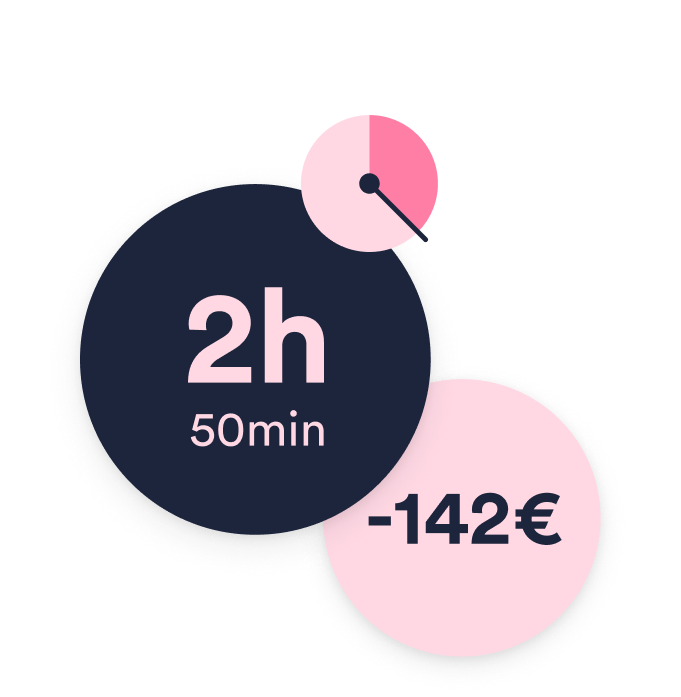
Based on 423,510 responses for IT incidents
When end-users give IT incident resolutions a high score (9-10 out of 10), the top reasons are the speed of service and human aspects related to the service agent's attitude and skills.
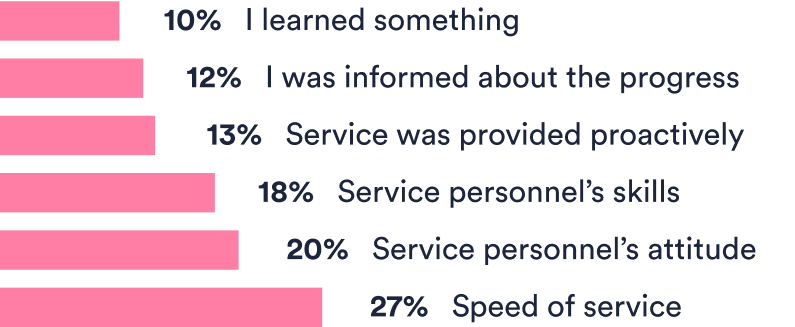
Based on 423,510 responses for IT incidents
Results are based on HappySignals customers' data, rolling 6 month average ending at the end of the indicated period.
| Positive Factors | Q4/'19 | Q1/'20 | Q2/'20 | Q3/'20 | Q4/'20 | H1/'21 | H2/'21 |
| Speed of Service | 30 % | 30 % | 29 % | 28 % | 28 % | 27 % | 27% |
| Service personnel's attitude | 21 % | 21 % | 21 % | 20 % | 20 % | 20 % | 20% |
| Service personnel's skills | 19 % | 18 % | 19 % | 18 % | 18 % | 18 % | 18% |
| I was informed about the progress | 12 % | 12 % | 12 % | 12 % | 13 % | 13 % | 13% |
| Service was provided proactively | 10 % | 11 % | 11 % | 12 % | 13 % | 13 % | 13% |
| I learned something | 8 % | 8 % | 9 % | 9 % | 9 % | 9 % | 9% |
Data set contains xM+ end-user responses between 2019-2021
Speed of service is by far the most cited factor when end-users give a neutral score (7-8 out of 10).
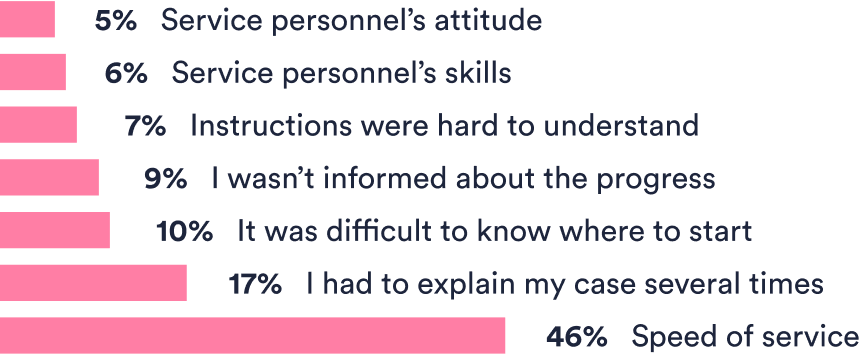
Based on 423,510 responses for IT incidents
Results are based on HappySignals customers' data, rolling 6 month average ending at the end of the indicated period.
| Neutral Factors | Q4/'19 | Q1/'20 | Q2/'20 | Q3/'20 | Q4/'20 | H1/'21 | H2/'21 |
| Speed of service | 46 % | 48 % | 48 % | 46 % | 46 % | 46 % | 45% |
| I had to explain my case several times | 16 % | 16 % | 16 % | 18 % | 18 % | 17 % | 17% |
| It was difficult to know where to start | 10 % | 10 % | 9 % | 9 % | 10 % | 10 % | 10% |
| I wasn't informed about the progress | 9 % | 9 % | 8 % | 9 % | 9 % | 9 % | 8% |
| Service personnel's skills | 8 % | 7 % | 7 % | 7 % | 7 % | 6 % | 7% |
| Instructions were hard to understand | 6 % | 6 % | 6 % | 6 % | 6 % | 7 % | 6% |
| Service personnel's attitude | 6 % | 5 % | 5 % | 5 % | 5 % | 5 % | 6% |
Data set contains xM+ end-user responses between 2019-2021
When end-users give negative scores (0-6 out of 10), the factors are often linked to the resolution process.
Ticket not being solved and having to explain the case several times may hint at ticket reassignments and prematurely closed tickets.
Based on 423,510 responses for IT incidents
Results are based on HappySignals customers' data, rolling 6 month average ending at the end of the indicated period.
| Negative Factors | Q4/'19 | Q1/'20 | Q2/'20 | Q3/'20 | Q4/'20 | H1/'21 | H2/21 |
| Service was slow | 28 % | 28 % | 28 % | 28 % | 25 % | 26 % | 28% |
| My ticket was not solved | 26 % | 25 % | 26 % | 26 % | 27 % | 27 % | 26% |
| I had to explain my case several times | 17 % | 17 % | 17 % | 17 % | 18 % | 17 % | 17% |
| I wasn't informed about the progress | 10 % | 10 % | 10 % | 10 % | 9 % | 9 % | 9% |
| Service personnel's skills | 7 % | 7 % | 7 % | 7 % | 7 % | 7 % | 7% |
| Instructions were hard to understand | 4 % | 4 % | 4 % | 4 % | 5 % | 5 % | 5% |
| It was difficult to know where to start | 4 % | 4 % | 4 % | 4 % | 4 % | 4 % | 4% |
| Service personnel's attitude | 4 % | 4 % | 4 % | 4 % | 4 % | 5 % | 4% |
Data set contains 3M+ end-user responses between 2019-2021
Results are based on HappySignals customers' data, rolling 6 month average ending at the end of the indicated period.
| Q4/'19 | Q1/'20 | Q2/'20 | Q3/'20 | Q4/'20 | H1/'21* | H2/'21 | |
| Chat | 8% | 7% | 8% | 8% | 9% | 8% | 9% |
| 20% | 19% | 18% | 17% | 17% | 16% | 15% | |
| Phone | 28% | 28% | 28% | 27% | 27% | 25% | 27% |
| Portal | 34% | 37% | 37% | 37% | 36% | 39% | 38% |
| Walk in | 4% | 4% | 3% | 2% | 2% | 2% | 4% |
*1.12.2020-31.5.2021
Results are based on HappySignals customers' data, rolling 6 month average ending at the end of the indicated period.
| Q4/'19 | Q1/'20 | Q2/'20 | Q3/'20 | Q4/'20 | H1/'21* | H2/'21 | |
| Chat | 62 | 61 | 64 | 68 | 70 | 74 | 75 |
| 67 | 66 | 68 | 73 | 73 | 75 | 77 | |
| Phone | 69 | 70 | 74 | 76 | 75 | 78 | 79 |
| Portal | 62 | 64 | 68 | 71 | 71 | 73 | 73 |
| Walk in | 90 | 89 | 90 | 91 | 90 | 92 | 92 |
*1.12.2020-31.5.2021
Results are based on HappySignals customers' data, rolling 6 month average ending at the end of the indicated period.
| Q4/'19 | Q1/'20 | Q2/'20 | Q3/'20 | Q4/'20 | H1/'21* | H2/'21 | |
| Chat | 2h 40min | 3h 10min | 3h 15min | 3h 4min | 2h 36min | 2h 29min | 2h 54min |
| 4h 00min | 3h 55min | 3h 43min | 3h 32min | 3h 35min | 3h 44min | 4h 10min | |
| Phone | 2h 25min | 2h 30min | 2h 27min | 2h 19min | 2h 10min | 2h 3min | 2h 8min |
| Portal | 4h 20min | 4h 34min | 4h 33min | 4h 28min | 4h 9min | 3h 59min | 3h 50min |
| Walk in | 1h 11min | 1h 13min | 1h 30min | 1h 49min | 1h 37min | 1h 53min | 1h 39min |
*1.12.2020-31.5.2021
Results are based on HappySignals customers' data, rolling 6 month average ending at the end of the indicated period.
The numbers do not add up to 100% as there is a small percentage of tickets that get reassigned more than 4 times.
| Reassignment count | Q4/'19 | Q1/'20 | Q2/'20 | Q3/'20 | Q4/'20 | H1/'21* | H2/'21 |
| 0 | 56% | 55% | 56% | 56% | 56% | 52% | 51% |
| 1 | 29% | 27% | 27% | 27% | 27% | 30% | 31% |
| 2 | 7% | 7% | 7% | 7% | 7% | 8% | 9% |
| 3 | 2% | 2% | 3% | 3% | 3% | 3% | 3% |
| 4 | 1% | 1% | 1% | 1% | 1% | 1% | 2% |
*1.12.2020-31.5.2021
Results are based on HappySignals customers' data, rolling 6 month average ending at the end of the indicated period.
| Reassignment count | Q4/'19 | Q1/'20 | Q2/'20 | Q3/'20 | Q4/'20 | H1/'21* | H2/'21 |
| 0 | 72 | 73 | 75 | 78 | 78 | 81 | 81 |
| 1 | 63 | 64 | 67 | 70 | 70 | 75 | 77 |
| 2 | 53 | 54 | 58 | 62 | 62 | 66 | 68 |
| 3 | 44 | 46 | 50 | 53 | 52 | 56 | 60 |
| 4 | 38 | 41 | 44 | 46 | 47 | 51 | 50 |
*1.12.2020-31.5.2021
Results are based on HappySignals customers' data, rolling 6 month average ending at the end of the indicated period.
| Reassignment count | Q4/'19 | Q1/'20 | Q2/'20 | Q3/'20 | Q4/'20 | H1/'21* | H2/'21 |
| 0 | 2h 17min | 2h 26min | 2h 18min | 2h 10min | 2h 2min | 1h 58min | 1h 52min |
| 1 | 3h 41min | 3h 55min | 3h 58min | 3h 55min | 3h 36min | 3h 17min | 3h 27min |
| 2 | 5h 51min | 6h 10min | 6h 5min | 5h 49min | 5h 27min | 5h 8min | 5h 10min |
| 3 | 7h 21min | 7h 52min | 7h 48min | 7h 35min | 7h 15min | 6h 22min | 6h 45min |
| 4 | 8h 20min | 8h 42min | 9h 21min | 9h 15min | 8h 2min | 7h 49min | 8h 24min |
*1.12.2020-31.5.2021
Now in H1/2021, one year after companies going remote, the number of requests have returned to pre Covid-19 levels
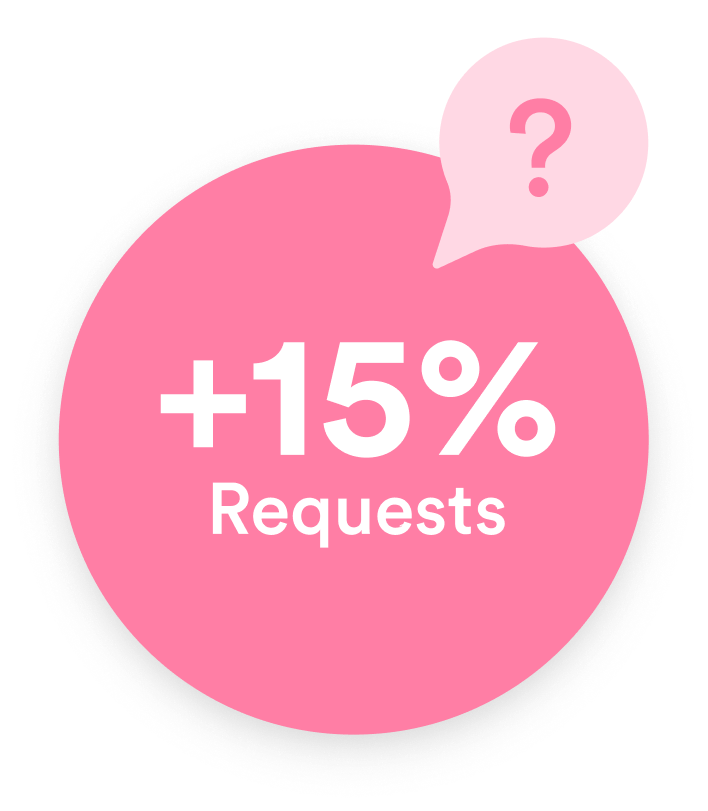
Based on 218,941 responses for IT requests
The number of requests went up by nearly 15% during the first half of 2020 when companies transitioned to remote work.
Despite the increased demands on Enterprise IT teams, the happiness decreased below pre Covid-19 levels. In fact, the happiness kept slowly going up by about 1 point per quarter, and has now reached a record high 80 points on average.
The results could be the result of IT end-users seeing how flexible and adaptive the IT Services were when faced with radical change, leading to a newfound appreciation for IT.
Another reason for rising scores could be the experience focus that HappySignals customers are pursuing.
In a rapidly changing environment, having real-time experience data does make it much easier for IT to match stakeholder expectations regardless of how circumstances and needs change.When end-users give IT request resolutions a high score (9-10 out of 10), the top reasons cited are speed of service, service personnel’s skills and attitude.
Based on 218,941 responses for IT Requests
Results are based on HappySignals customers' data, rolling 6 month average ending at the end of the indicated quarter.
| Positive Factors | Q4/'19 | Q1/'20 | Q2/'20 | Q3/'20 | Q4/'20 | H1/'21 | H2/'21 |
| Speed of service | 30 % | 30 % | 30 % | 29% | 29 % | 29 % | 29% |
| Service Personnel's attitude | 19 % | 18 % | 18 % | 18 % | 18 % | 18 % | 17% |
| Service personnel's skills | 17 % | 17 % | 17 % | 17 % | 17 % | 17 % | 16% |
| I was informed about the progress | 12 % | 12 % | 12 % | 12 % | 13 % | 13 % | 13% |
| It was easy to describe what I wanted | 12 % | 12 % | 12 % | 12 % | 12 % | 12 % | 12% |
| Instructions were easy to understand | 11 % | 11 % | 11 % | 11 % | 11 % | 11 % | 12% |
The top 2 neutral factors are the same as top 2 negative factors, related to speed of service and having to explain case several times.
Based on 218,941 responses for IT Requests
Results are based on HappySignals customers' data, rolling 6 month average ending at the end of the indicated quarter.
| Neutral Factors | Q4/'19 | Q1/'20 | Q2/'20 | Q3/'20 | Q4/'20 | H1/'21 | H2/'21 |
| Speed of service | 46 % | 47 % | 47 % | 45 % | 45 % | 47 % | 48% |
| I had to explain my case several times | 13 % | 13 % | 14 % | 14 % | 15 % | 13 % | 12% |
| It was difficult to know where to start | 8 % | 9 % | 8 % | 10 % | 9 % | 10 % | 9% |
| I wasn't informed about the progress | 9 % | 10 % | 10 % | 8 % | 9 % | 9 % | 9% |
| It was difficult to describe what I needed | 7 % | 6 % | 7 % | 7 % | 7 % | 7 % | 7% |
| Instructions were hard to understand | 6 % | 6 % | 6 % | 6 % | 6 % | 6 % | 6% |
| Service personnel's skills | 6 % | 5 % | 5 % | 6 % | 5 % | 5 % | 4% |
| Service personnel's attitude | 5 % | 4 % | 4 % | 4 % | 4 % | 4 % | 4% |
When end-users are turning to IT with IT requests, a good score is much more likely if IT can:
Keeping in mind that Service Portals constitute the first touchpoint in 51% of the requests, understanding the felt user experience in the portal is important.
In our global benchmark scores of all IT touchpoints, portal as a tool received the lowest score of all -26.
When end-users submit IT requests, negative scores are likely if the service is slow and they have to explain the request several times.
Based on 218,941 responses for IT Requests
Results are based on HappySignals customers' data, rolling 6 month average ending at the end of the indicated quarter.
| Negative Factors | Q4/'19 | Q1/'20 | Q2/'20 | Q3/'20 | Q4/'20 | H1/'21 | H2/'21 |
| Service was slow | 34 % | 35 % | 34 % | 33 % | 33 % | 35 % | 35% |
| I had to explain my case several times | 20 % | 20 % | 20 % | 20 % | 20 % | 20 % | 18% |
| I wasn't informed about the progress | 13 % | 15 % | 16 % | 16 % | 16 % | 15 % | 17% |
| Service personnel's skills | 11 % | 10 % | 10 % | 10 % | 10 % | 8 % | 8% |
| Instructions were hard to understand | 6 % | 7 % | 6 % | 6 % | 7 % | 6 % | 7% |
| It was difficult to know where to start | 6 % | 5 % | 5 % | 6 % | 6 % | 6 % | 6% |
| Service personnel's attitude | 5 % | 5 % | 5 % | 5 % | 6 % | 5 % | 5% |
| It was difficult to describe what I needed | 4 % | 4 % | 3 % | 4 % | 4 % | 4 % | 4% |
The most common reason for end-users to give a negative score for IT requests is slow service
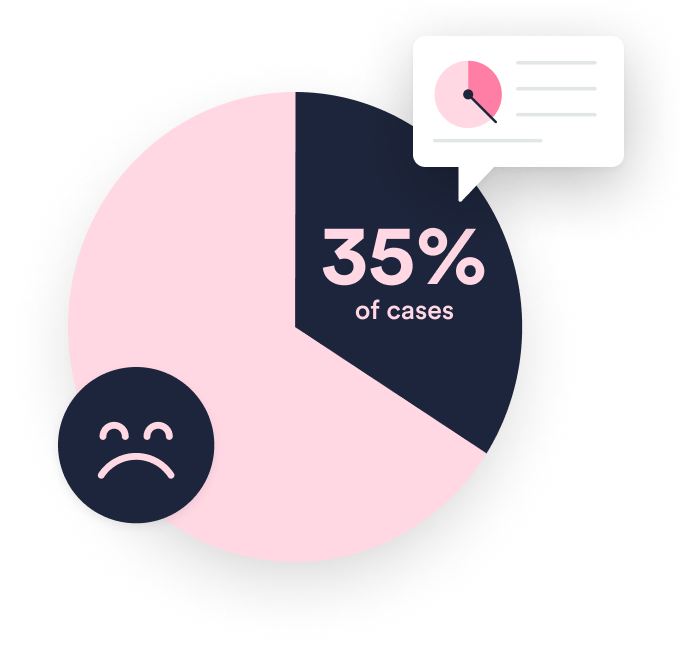
Based on 218,941 responses for IT requests
Results are based on HappySignals customers' data, rolling 6 month average ending at the end of the indicated period.
| Q4/'19 | Q1/'20 | Q2/'20 | Q3/'20 | Q4/'20 | H1/'21* | H2/'21 | |
| Chat | 2% | 2% | 3% | 3% | 3% | 3% | 3% |
| 15% | 15% | 14% | 14% | 15% | 14% | 8% | |
| Phone | 22% | 21% | 20% | 19% | 19% | 18% | 11% |
| Portal | 45% | 43% | 40% | 40% | 47% | 51% | 56% |
| Walk in | 1% | 2% | 2% | 1% | 2% | 2% | 1% |
| Other | 12% | 21% |
*1.12.2020-31.5.2021
Results are based on HappySignals customers' data, rolling 6 month average ending at the end of the indicated period.
| Q4/'19 | Q1/'20 | Q2/'20 | Q3/'20 | Q4/'20 | H1/'21* | H2/'21 | |
| Chat | 74 | 72 | 72 | 75 | 75 | 76 | 73 |
| 73 | 72 | 74 | 76 | 76 | 77 | 73 | |
| Phone | 81 | 82 | 84 | 85 | 84 | 86 | 84 |
| Portal | 74 | 73 | 75 | 77 | 76 | 79 | 81 |
| Walk in | 92 | 92 | 91 | 92 | 93 | 93 | 92 |
*1.12.2020-31.5.2021
Results are based on HappySignals customers' data, rolling 6 month average ending at the end of the indicated period.
| Q4/'19 | Q1/'20 | Q2/'20 | Q3/'20 | Q4/'20 | H1/'21* | H2/'21 | |
| Chat | 2h 29min | 2h 11min | 2h 7min | 1h 59min | 1h 58min | 2h 1min | 2h 35min |
| 2h 43min | 2h 36min | 2h 37min | 2h 36min | 2h 29min | 2h 36min | 3h 42min | |
| Phone | 1h 0min | 59min | 58min | 55min | 57min | 56min | 1h 2min |
| Portal | 2h 59min | 3h 0min | 2h 58min | 2h 55min | 3h 17min | 3h 12min | 2h 54min |
| Walk in | 45min | 54min | 53min | 53min | 1h 5min | 1h 6min | 1h 13min |
*1.12.2020-31.5.2021
Results are based on HappySignals customers' data, rolling 6 month average ending at the end of the indicated period.
| Reassignment count | Q4/'19 | Q1/'20 | Q2/'20 | Q3/'20 | Q4/'20 | H1/'21* | H2/'21 |
| 0 | 61% | 61% | 63% | 65% | 66% | 69% | 70% |
| 1 | 26% | 25% | 25% | 25% | 24% | 22% | 20% |
| 2 | 6% | 5% | 5% | 5% | 5% | 5% | 6% |
| 3 | 2% | 2% | 2% | 2% | 2% | 1% | 1% |
| 4 | 1% | 1% | 1% | 1% | 1% | 1% | 1% |
*1.12.2020-31.5.2021
Results are based on HappySignals customers' data, rolling 6 month average ending at the end of the indicated period.
| Reassignment count | Q4/'19 | Q1/'20 | Q2/'20 | Q3/'20 | Q4/'20 | H1/'21* | H2/'21 |
| 0 | 79 | 79 | 80 | 80 | 80 | 82 | 83 |
| 1 | 75 | 76 | 76 | 77 | 78 | 79 | 79 |
| 2 | 66 | 63 | 65 | 69 | 68 | 69 | 72 |
| 3 | 64 | 63 | 64 | 65 | 62 | 63 | 64 |
| 4 | 50 | 51 | 55 | 57 | 56 | 59 | 57 |
*1.12.2020-31.5.2021
Results are based on HappySignals customers' data, rolling 6 month average ending at the end of the indicated period.
| Reassignment count | Q4/'19 | Q1/'20 | Q2/'20 | Q3/'20 | Q4/'20 | H1/'21* | H2/'21 |
| 0 | 1h 43min | 1h 41min | 1h 54min | 2h 4min | 1h 59min | 2h 4min | 2h 45min |
| 1 | 2h 38min | 2h 32min | 2h 41min | 2h 42min | 2h 40min | 2h 50min | 2h 56min |
| 2 | 3h 56min | 4h 19min | 4h 19min | 3h 45min | 3h 51min | 4h 12min | 4h 18min |
| 3 | 5h 5min | 4h 23min | 4h 32min | 5h 5min | 5h 16min | 4h 59min | 5h 47min |
| 4 | 5h 48min | 5h 28min | 5h 44min | 6h 0min | 6h 15min | 5h 53min | 6h 25min |
*1.12.2020-31.5.2021
HappySignals captures 4 distinct types of IT end-user support profiles - Doer, Prioritiser, Supported, and Trier.
Each profile has different needs and wants when interacting with IT support and services.

Doers are capable of solving IT-related problems themselves. People often ask Doers for help. Sometimes Doers will even try to teach others to solve problems themselves. Hence when asking for support, Doers want expert help.
Guide on using Support Profiles in IT Service Desk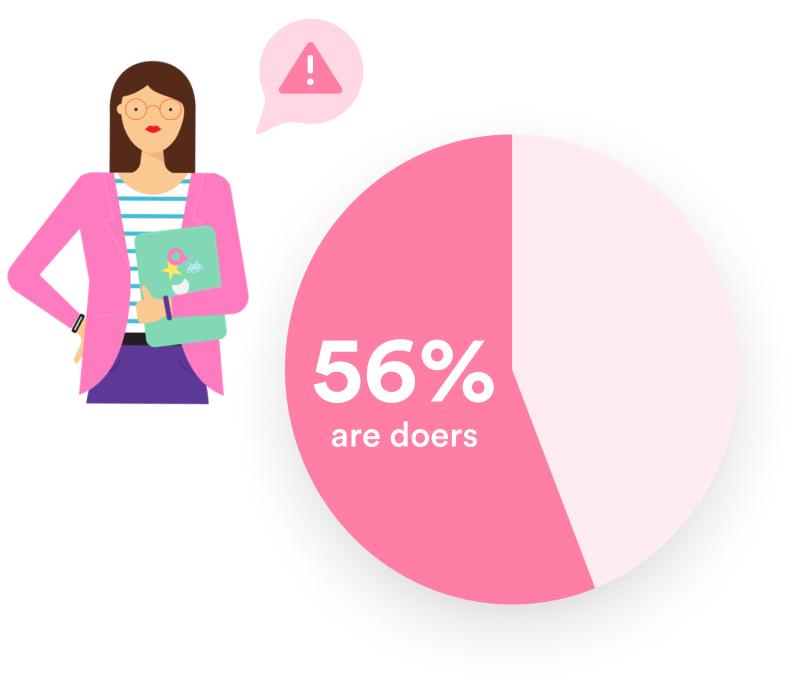
| Support Profile | Q1/'17* | Q1/'18 | Q1/'19 | Q1/'20 | H1/'21 | H2/'21 |
| Doer | 49% | 58% | 60% | 56% | 56% | 54% |
| Prioritiser | 38% | 23% | 21% | 21% | 20% | 19% |
| Supported | 10% | 14% | 14% | 15% | 17% | 19% |
| Trier | 3% | 6% | 5% | 7% | 8% | 8% |
* In 2017 most customers were from Finland
During the last Happiness Score™ Report measurement period, the share of tickets submitted by untechnical employees grew by 8%.
It is the type of end-users that might feel more comfortable asking a colleague for help in the office, than turning to IT.
When remote work became the norm, it was naturally much harder for these untechnical persons to ask their colleagues for help.
Another possible reason for untechnical end-users increased share of interactions with IT could be a result of devices at home not being set up the same way, requiring things like a secure VPN, access to files remotely etc. Issues that were very common in Q2/2020.
8% more untechnical people (Supported and Triers) contacted IT Service Desks during the pandemic than before.
We believe this is because peer support is not as readily accessible as it was when everybody was in the office together.
Based on 423,510 responses for IT incidents
Service Personnels' skills and attitude, alongside speed of service, have consistently been the most commonly linked factors for a good score.
That human touch is visible when comparing end-user happiness across all measured IT touchpoints.
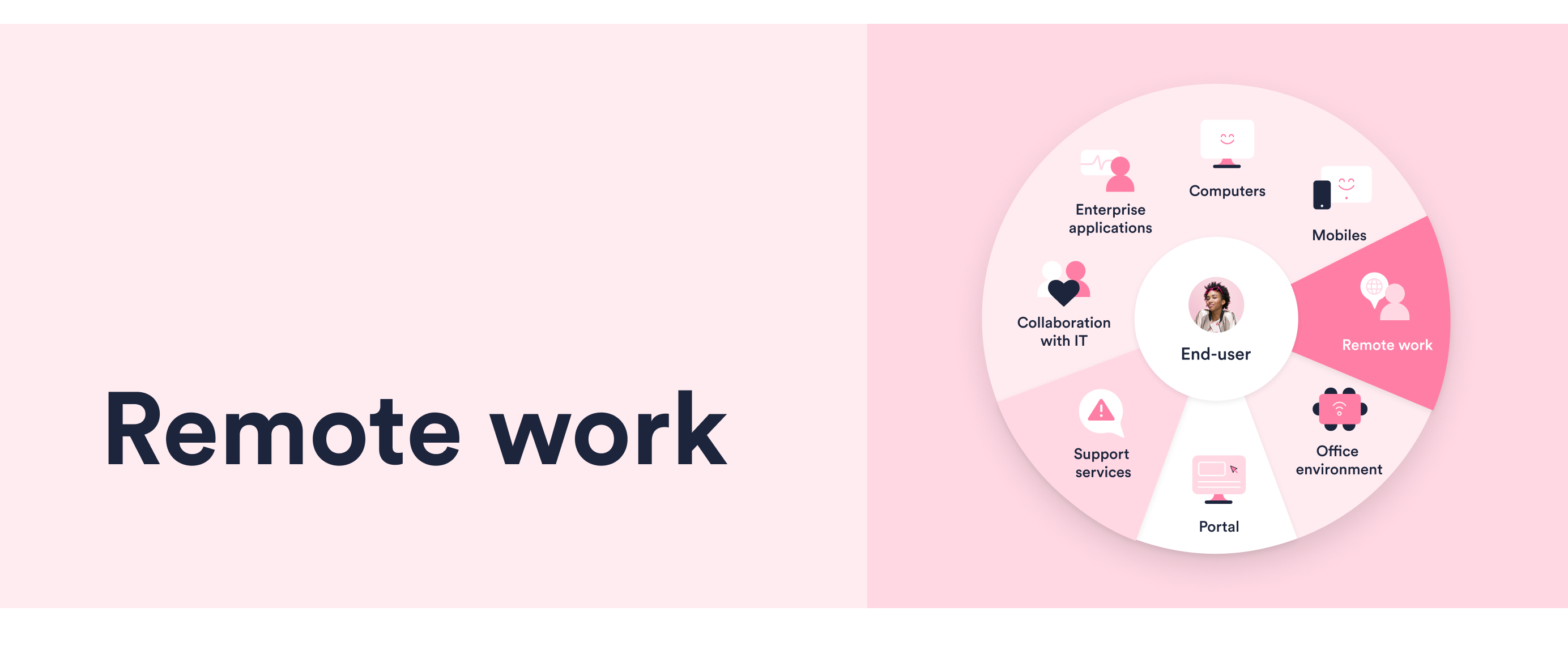
We made the Remote Work survey available to our customers in the beginning of the pandemic. As the results started coming in, it was interesting to see certain changes as the months went by.
In the beginning, people were most unhappy with VPN access and their internet connection. Once IT got those connection issues sorted, but as remote work continued, the ergonomics of the home office started to be the issue. End-users were missing their second screen and other office equipment that they did not have access to at home.
When equipment, connections and other material needs were met, the collaboration challenges with colleagues started to get more attention from end-users.
We have already seen in the IT incident and request data, that human interaction is highly valued by end-users. As people realise that collaborating in person may not go back to what it was before, best practices for collaboration in a remote setting seem more important than before.
HappySignals created the survey to measure the Remote Work Experience in March 2020.
Since then, we have gathered 321,935 responses. In this report, we use 120,409 responses from December 2020 to May 2021.

Top factors for end-users to be happy with remote work are related to interpersonal aspects
Top 3 factors for neutral feedback are the same as they are for negative feedback
The reasons for negative feedback in relation to remote work have slightly changed since the first half of 2020 but connection issues and workspace ergonomics are still on the top.
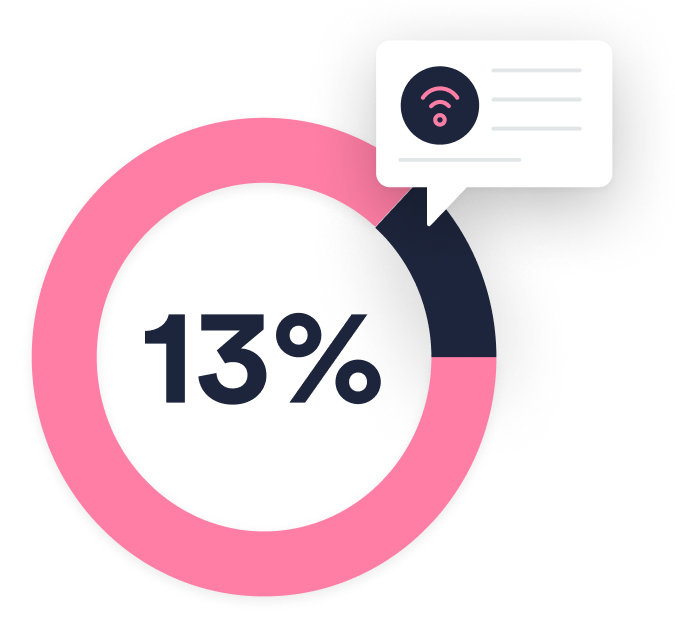
Based on 120,409 responses on remote work
When we looked at the country specific happiness with remote work, we started wondering why certain regions and countries were scoring remote work in a certain way.
Crossing the data between "Happiest Countries in the World 2021" and our Happiness Score™ with our own data around IT Happiness, an interesting pattern showed up.
There is a negative relationship between how happy people say they are in their countries, and how they score happiness regarding IT services.
End-users are impacted by their environment, and the way they rate IT services is not only reflective of service quality.
Using benchmark data to compare changes in country and IT happiness, can lead IT to make better decisions in allocating more or less resources to certain locations.
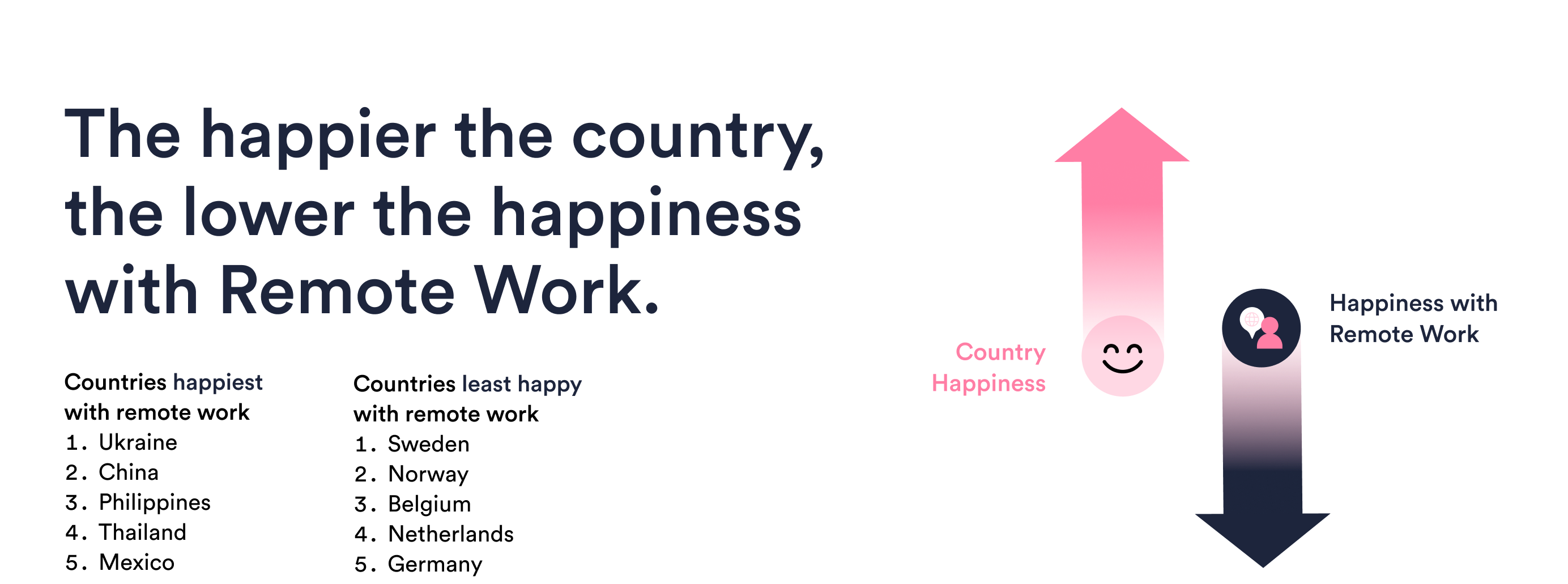
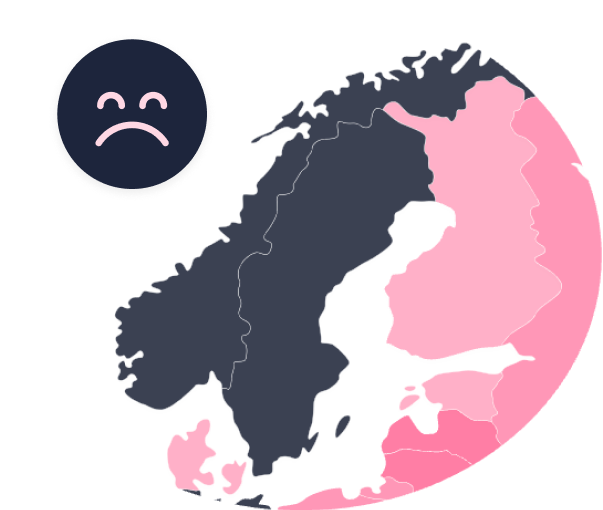
Based on 120,409 end-user responses
It has been interesting to see how expectations regarding remote work have shifted over the months. In the beginning, connection problems were common. Then IT took care of those.
After a few months, employees started noticing how their productivity and comfort was impacted by the home office environment.
Now after a year of working remotely and realising that for many remote work is likely to continue in one way or another, the expectations towards collaboration practices are rising.
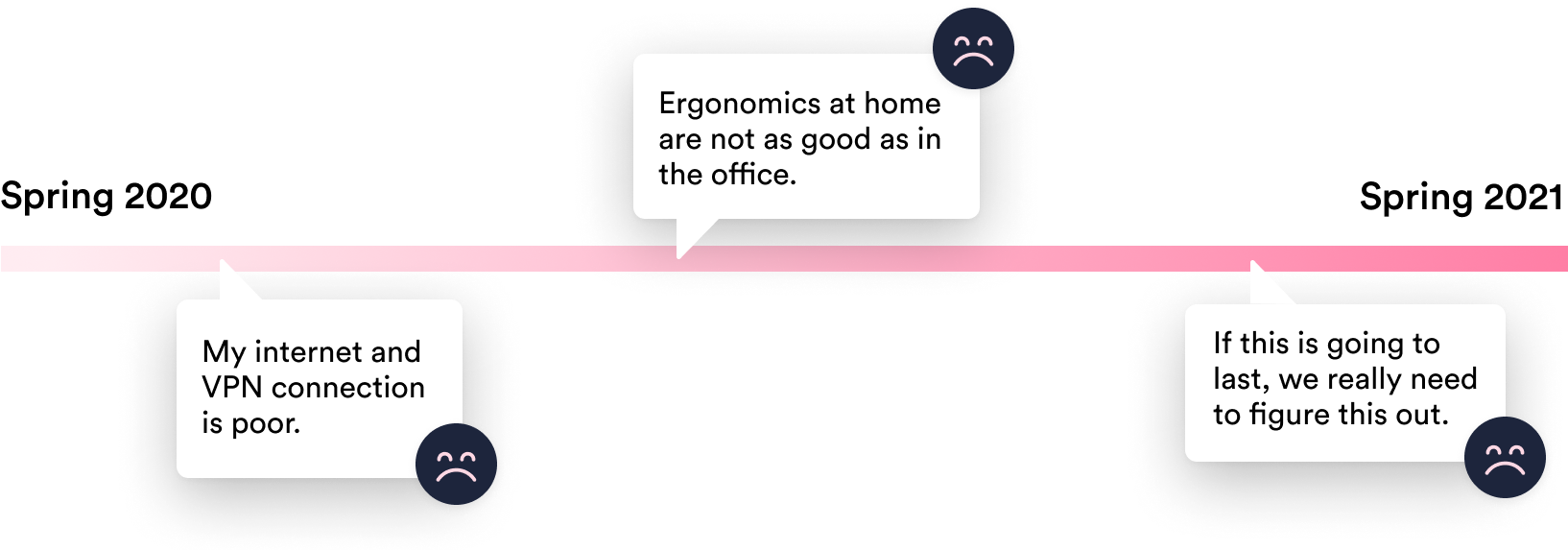
| Terms used in the report | Definition |
| Happiness | End-user satisfaction with internal IT services on a 10 point scale |
| Productivity | End-user perception of lost time with IT incidents/requests |
| Factors | Reasons influencing happiness, as selected by end-users on standardised surveys (e.g. speed of service, agent attitude etc) |
| Happiness Score™ |
Happiness + Productivity + Factors
Combined system for measurement and representation of end-user happiness and productivity in relation to internal IT services and support.
|
| HappySignals Experience Management Platform for IT |
SaaS platform that integrates with ITSM tools to bring together IT end-user feedback with operational data.
|

